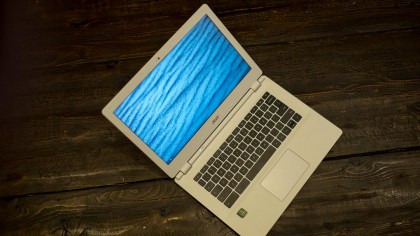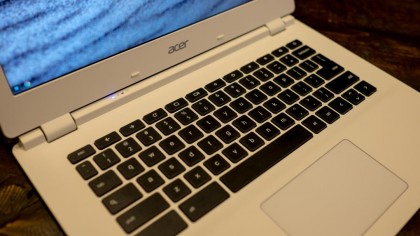Why you can trust TechRadar
For the Chromebook 13, Acer ditched Intel's Celeron line of processors for a quad-core 2.1GHz Nvidia Tegra K1 CPU. In my experience, the notebook handled browsing the web, composing a document or streaming music with aplomb, but performance slowed down noticeably when I opened more than a dozen tabs. The Chromebook 13 also ships with a 16GB solid-state drive, although almost nothing in Chrome OS needs to saved locally.

Spec sheet
Here is the Chromebook 13 configuration given to TechRadar for this review:
- CPU: 2.1GHz Nvidia Tegra K1 CD570M-A1 (quad-core)
- Graphics: Nvidia Keplar
- RAM: 2GB DDR3 (1,333MHz)
- Screen: 13.3-inch, 1.920 x 1.080
- Storage: 16GB SSD
- Ports: 2 x USB 3.0, HDMI, SD card slot, headphone/mic jack
- Connectivity: 802.11ac Wi-Fi, Bluetooth 4.0
- Camera: 720p HD webcam
- Weight: 3.31 pounds
- Size: 12.9 x 9 x 0.71 inches (W x D x H)
At $249, this laptop is on par with typical Chromebooks, which is a surprise given its quad-core Tegra K1 processor and full HD display. By comparison, the Toshiba Chromebook 2 features a dual-core Intel Celeron N2840 processor, 4GB of RAM and a 1080p panel for $329 (£217, AU$407). The Samsung Chromebook 2 11, which also retails for $249 (£166, AU$314), uses a dual-core N2840 processor, 2GB of RAM and a 1366 x 768 display.
Unfortunately, a configuration with a 1080p screen is not available in the UK. Instead, users in Europe are limited only to 1366 x 768 models that start at £219. Shoppers in Australia will be even more disappointed, as the Chromebook 13 is not even listed on Acer's site, which only leaves the option of importing a unit for about AU$314.
Performance
The Chromebook 13 easily handles simple tasks like browsing the web with a few tabs open or streaming 1080p video, but it struggled when I streamed music on Pandora with more than a dozen tabs open. I noticed a half-second delay when I typed in the address bar, for example, and Chrome occasionally froze for several seconds whenever I opened a website in a new tab.

Doubling the memory would have significantly improved the Chromebook 13's performance at very little cost. The 11-inch Samsung Chromebook 2, which also uses 2GB of RAM, suffered from noticeable stuttering. By comparison, the Toshiba Chromebook 2, which uses 4GB of RAM, had no trouble streaming music on Google Play with 18 tabs open in Chrome.
Mediocre visuals
Text and graphics look sharp on the Chromebook's 13.3-inch, 1920 x 1080 screen, but the panel suffers from poor color reproduction. When I watched a high-definition trailer for Star Wars: The Force Awakens, large swathes of the desert and sky appeared muddled, and I noticed pixelation in areas of darkness. Colors in the Jurassic World trailer likewise failed to pop.
Sign up to the TechRadar Pro newsletter to get all the top news, opinion, features and guidance your business needs to succeed!

The display also suffers from shallow viewing angles. The screen dimmed noticeably when I rotated the laptop a few degrees to the left or right, and when I push the display towards the keyboard the colors began to wash out. This could make using the Chromebook 13 in a cramped environment a bit tricky, as the screen needs to be tilted quite far backward for an optimal viewing experience.
No need for external speakers
Thankfully, the Chromebook 13's speakers hit almost all the right notes. Audio sounds remarkably clear and well-balanced, and I didn't notice any distortion when I cranked the volume to the maximum. Playing Radiohead's "Reckoner," I could hear each snap of the drums, and Thom Yorke's lilting vocals filled the room.

As with most Chromebooks, however, the bass is virtually nonexistent. When I queued up Radiohead's bass-heavy "Idioteque," the electronic beat fell flat. Audio also tended to become muffled when I listened to music with the notebook in my lap, due to the speakers' position on the bottom of the chassis.
Typist's dream
The laptop's island-style keyboard is one of the better I've used on a Chromebook. The chiclet-shaped keys offer plenty of vertical travel and tactile feedback, and the spacing is generous enough that I only made a few adjacent-key errors. I also didn't notice any flex in the keyboard as I wrote this review.
The spacious touchpad is a joy to use as well. Gestures such as two-finger scrolling and three-finger swiping perform reliably, and the pad doesn't require excessive force to depress. As with most Chromebooks, you have to tap with two fingers to open the right-click menu.
Best-in-class battery life
Nvidia promised unprecedented efficiency with the Tegra K1 processor, and it wasn't kidding. The Chromebook 13 lasts longer on a charge than any Chromebook I've seen. While writing this review with the brightness at 50%, watching YouTube videos and streaming music on Pandora, the notebook lasted a jaw-dropping 8 hours and 56 minutes. That's an hour longer than the Samsung Chromebook 2 11, and more than two hours longer than the Toshiba Chromebook 2.
